Urban Tourism: Literature Review on Trends, Issues, and Impacts
VerifiedAdded on 2020/07/22
|6
|1500
|41
Literature Review
AI Summary
This literature review provides an overview of urban tourism, exploring key concepts such as demand and supply dynamics, current debates surrounding sustainability and overtourism, and the impact of urban tourism on historic cities like London. It examines the perspectives of residents, highlighting both positive impacts like improved education and communication, and negative impacts such as the deterioration of cultural heritage and social issues. The review also discusses urban tourism planning, the importance of resident cooperation, and the need for balanced development considering economic, social, and environmental factors. The review draws upon various sources including academic journals, books, and online resources to provide a comprehensive understanding of the subject.
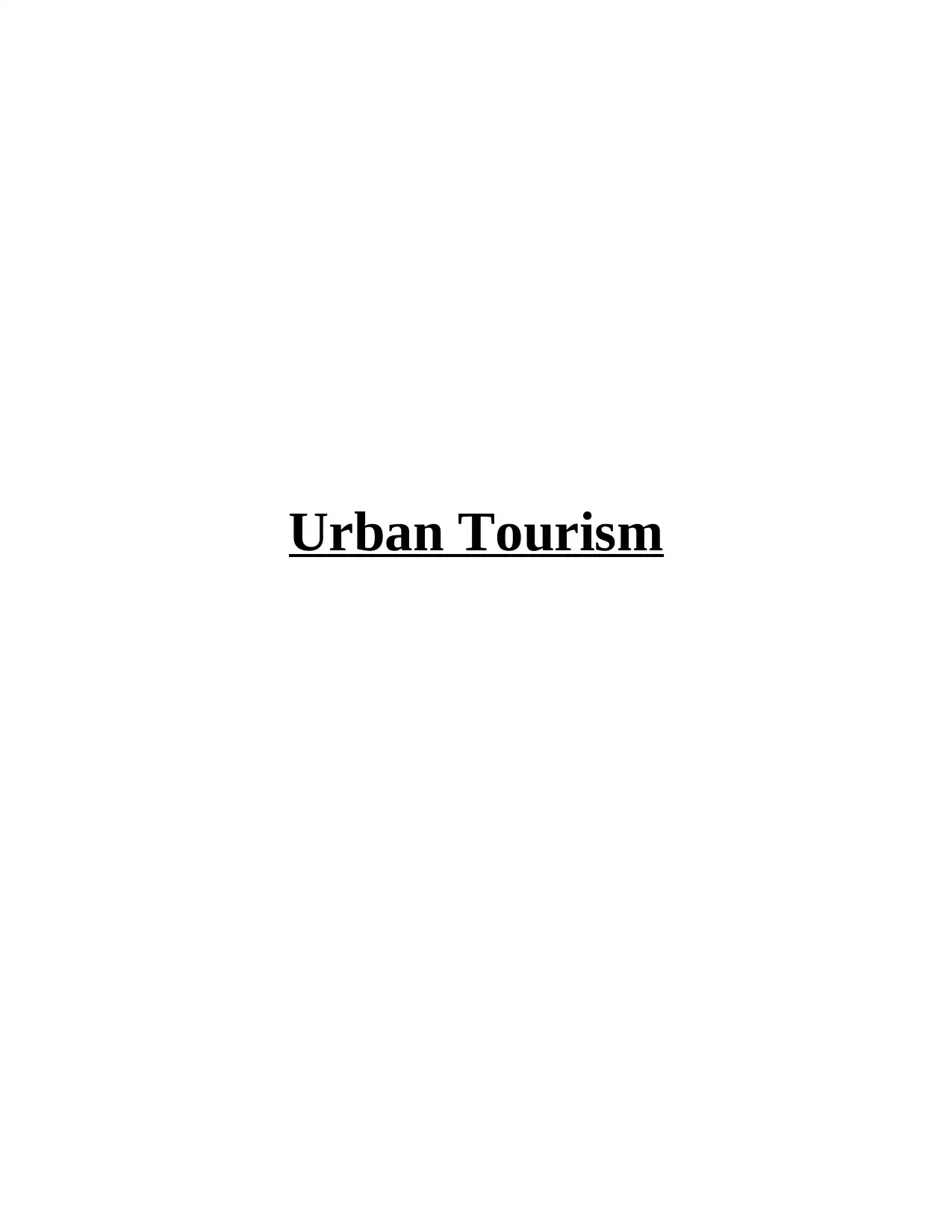
Urban Tourism
Paraphrase This Document
Need a fresh take? Get an instant paraphrase of this document with our AI Paraphraser

TABLE OF CONTENTS
LITERATURE REVIEW................................................................................................................1
REFERENCES................................................................................................................................4
LITERATURE REVIEW................................................................................................................1
REFERENCES................................................................................................................................4
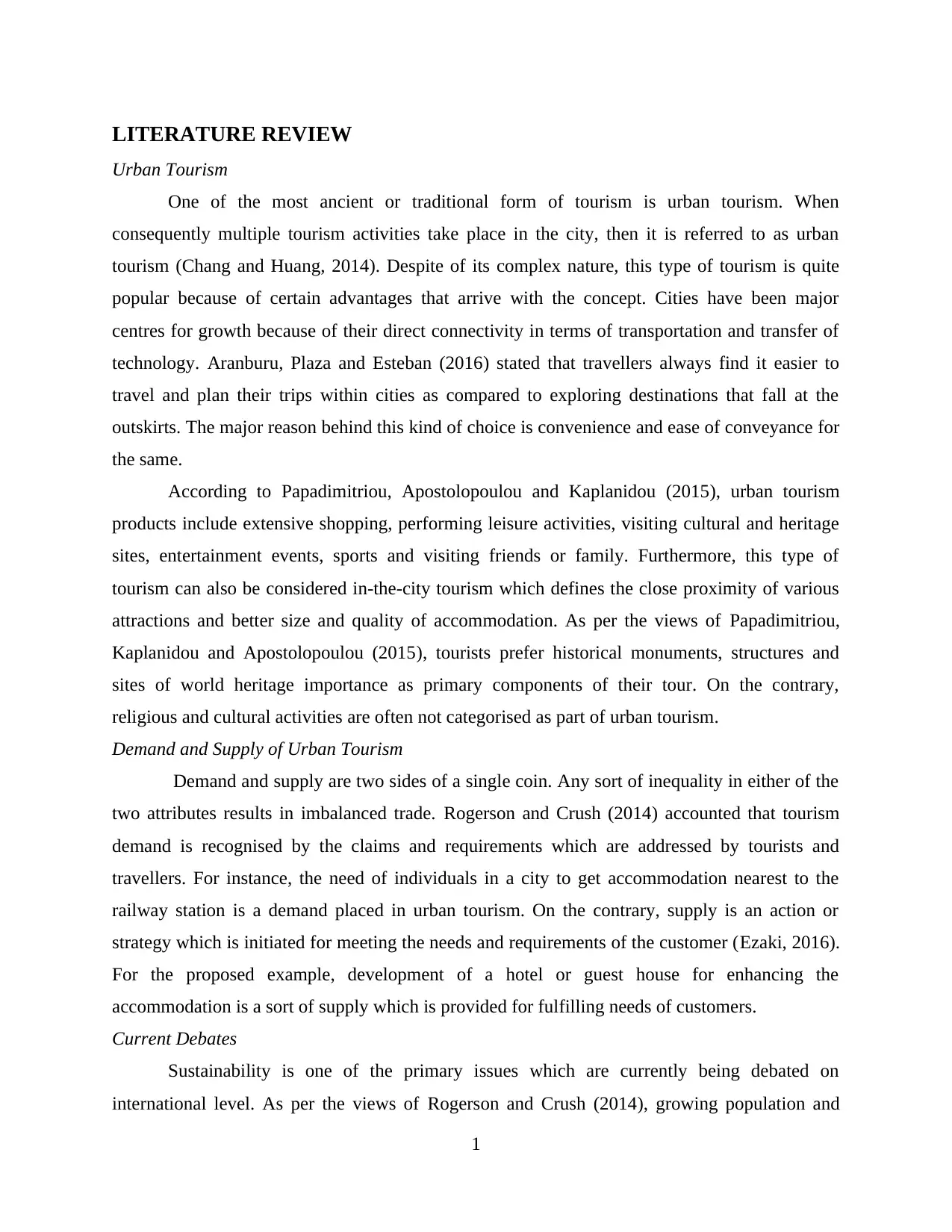
LITERATURE REVIEW
Urban Tourism
One of the most ancient or traditional form of tourism is urban tourism. When
consequently multiple tourism activities take place in the city, then it is referred to as urban
tourism (Chang and Huang, 2014). Despite of its complex nature, this type of tourism is quite
popular because of certain advantages that arrive with the concept. Cities have been major
centres for growth because of their direct connectivity in terms of transportation and transfer of
technology. Aranburu, Plaza and Esteban (2016) stated that travellers always find it easier to
travel and plan their trips within cities as compared to exploring destinations that fall at the
outskirts. The major reason behind this kind of choice is convenience and ease of conveyance for
the same.
According to Papadimitriou, Apostolopoulou and Kaplanidou (2015), urban tourism
products include extensive shopping, performing leisure activities, visiting cultural and heritage
sites, entertainment events, sports and visiting friends or family. Furthermore, this type of
tourism can also be considered in-the-city tourism which defines the close proximity of various
attractions and better size and quality of accommodation. As per the views of Papadimitriou,
Kaplanidou and Apostolopoulou (2015), tourists prefer historical monuments, structures and
sites of world heritage importance as primary components of their tour. On the contrary,
religious and cultural activities are often not categorised as part of urban tourism.
Demand and Supply of Urban Tourism
Demand and supply are two sides of a single coin. Any sort of inequality in either of the
two attributes results in imbalanced trade. Rogerson and Crush (2014) accounted that tourism
demand is recognised by the claims and requirements which are addressed by tourists and
travellers. For instance, the need of individuals in a city to get accommodation nearest to the
railway station is a demand placed in urban tourism. On the contrary, supply is an action or
strategy which is initiated for meeting the needs and requirements of the customer (Ezaki, 2016).
For the proposed example, development of a hotel or guest house for enhancing the
accommodation is a sort of supply which is provided for fulfilling needs of customers.
Current Debates
Sustainability is one of the primary issues which are currently being debated on
international level. As per the views of Rogerson and Crush (2014), growing population and
1
Urban Tourism
One of the most ancient or traditional form of tourism is urban tourism. When
consequently multiple tourism activities take place in the city, then it is referred to as urban
tourism (Chang and Huang, 2014). Despite of its complex nature, this type of tourism is quite
popular because of certain advantages that arrive with the concept. Cities have been major
centres for growth because of their direct connectivity in terms of transportation and transfer of
technology. Aranburu, Plaza and Esteban (2016) stated that travellers always find it easier to
travel and plan their trips within cities as compared to exploring destinations that fall at the
outskirts. The major reason behind this kind of choice is convenience and ease of conveyance for
the same.
According to Papadimitriou, Apostolopoulou and Kaplanidou (2015), urban tourism
products include extensive shopping, performing leisure activities, visiting cultural and heritage
sites, entertainment events, sports and visiting friends or family. Furthermore, this type of
tourism can also be considered in-the-city tourism which defines the close proximity of various
attractions and better size and quality of accommodation. As per the views of Papadimitriou,
Kaplanidou and Apostolopoulou (2015), tourists prefer historical monuments, structures and
sites of world heritage importance as primary components of their tour. On the contrary,
religious and cultural activities are often not categorised as part of urban tourism.
Demand and Supply of Urban Tourism
Demand and supply are two sides of a single coin. Any sort of inequality in either of the
two attributes results in imbalanced trade. Rogerson and Crush (2014) accounted that tourism
demand is recognised by the claims and requirements which are addressed by tourists and
travellers. For instance, the need of individuals in a city to get accommodation nearest to the
railway station is a demand placed in urban tourism. On the contrary, supply is an action or
strategy which is initiated for meeting the needs and requirements of the customer (Ezaki, 2016).
For the proposed example, development of a hotel or guest house for enhancing the
accommodation is a sort of supply which is provided for fulfilling needs of customers.
Current Debates
Sustainability is one of the primary issues which are currently being debated on
international level. As per the views of Rogerson and Crush (2014), growing population and
1
⊘ This is a preview!⊘
Do you want full access?
Subscribe today to unlock all pages.

Trusted by 1+ million students worldwide
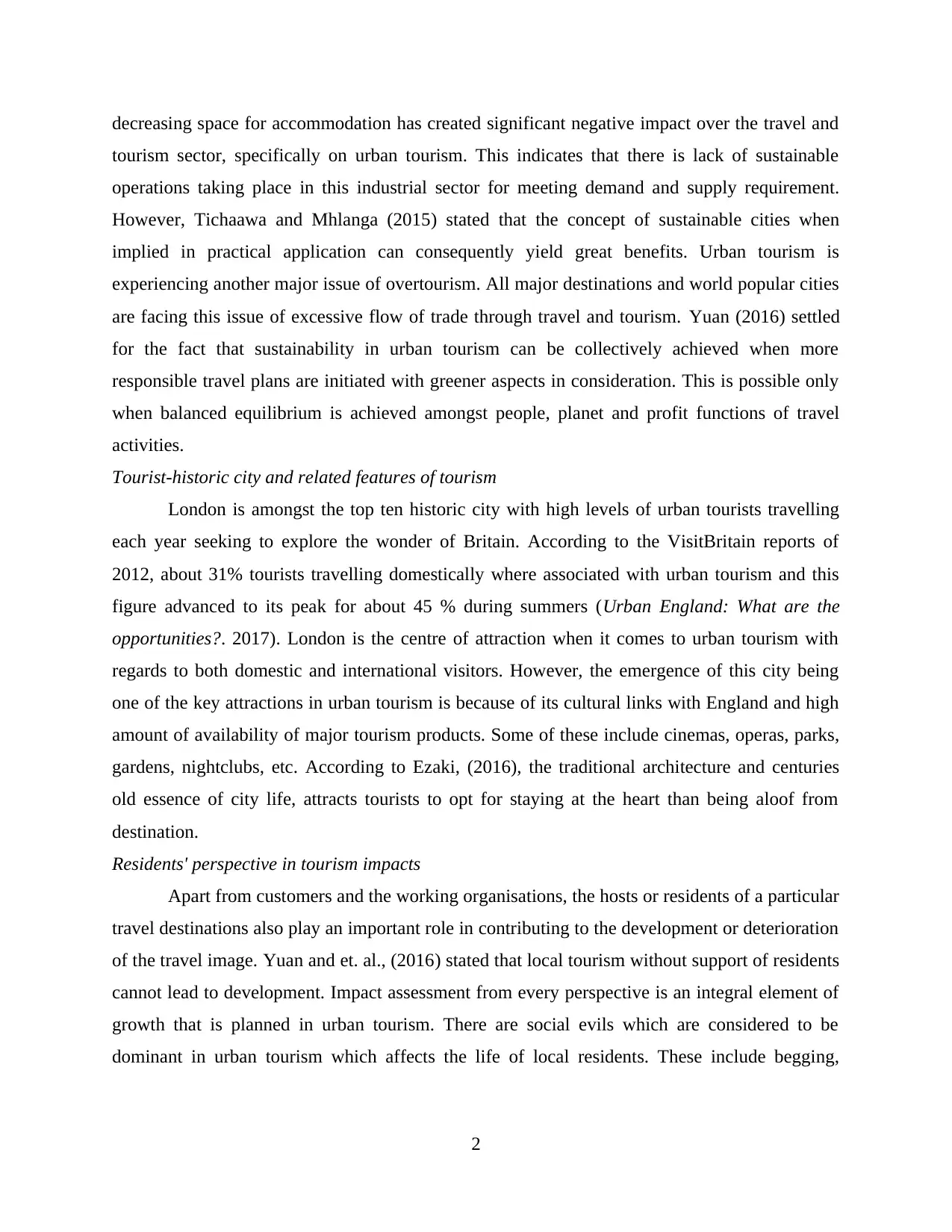
decreasing space for accommodation has created significant negative impact over the travel and
tourism sector, specifically on urban tourism. This indicates that there is lack of sustainable
operations taking place in this industrial sector for meeting demand and supply requirement.
However, Tichaawa and Mhlanga (2015) stated that the concept of sustainable cities when
implied in practical application can consequently yield great benefits. Urban tourism is
experiencing another major issue of overtourism. All major destinations and world popular cities
are facing this issue of excessive flow of trade through travel and tourism. Yuan (2016) settled
for the fact that sustainability in urban tourism can be collectively achieved when more
responsible travel plans are initiated with greener aspects in consideration. This is possible only
when balanced equilibrium is achieved amongst people, planet and profit functions of travel
activities.
Tourist-historic city and related features of tourism
London is amongst the top ten historic city with high levels of urban tourists travelling
each year seeking to explore the wonder of Britain. According to the VisitBritain reports of
2012, about 31% tourists travelling domestically where associated with urban tourism and this
figure advanced to its peak for about 45 % during summers (Urban England: What are the
opportunities?. 2017). London is the centre of attraction when it comes to urban tourism with
regards to both domestic and international visitors. However, the emergence of this city being
one of the key attractions in urban tourism is because of its cultural links with England and high
amount of availability of major tourism products. Some of these include cinemas, operas, parks,
gardens, nightclubs, etc. According to Ezaki, (2016), the traditional architecture and centuries
old essence of city life, attracts tourists to opt for staying at the heart than being aloof from
destination.
Residents' perspective in tourism impacts
Apart from customers and the working organisations, the hosts or residents of a particular
travel destinations also play an important role in contributing to the development or deterioration
of the travel image. Yuan and et. al., (2016) stated that local tourism without support of residents
cannot lead to development. Impact assessment from every perspective is an integral element of
growth that is planned in urban tourism. There are social evils which are considered to be
dominant in urban tourism which affects the life of local residents. These include begging,
2
tourism sector, specifically on urban tourism. This indicates that there is lack of sustainable
operations taking place in this industrial sector for meeting demand and supply requirement.
However, Tichaawa and Mhlanga (2015) stated that the concept of sustainable cities when
implied in practical application can consequently yield great benefits. Urban tourism is
experiencing another major issue of overtourism. All major destinations and world popular cities
are facing this issue of excessive flow of trade through travel and tourism. Yuan (2016) settled
for the fact that sustainability in urban tourism can be collectively achieved when more
responsible travel plans are initiated with greener aspects in consideration. This is possible only
when balanced equilibrium is achieved amongst people, planet and profit functions of travel
activities.
Tourist-historic city and related features of tourism
London is amongst the top ten historic city with high levels of urban tourists travelling
each year seeking to explore the wonder of Britain. According to the VisitBritain reports of
2012, about 31% tourists travelling domestically where associated with urban tourism and this
figure advanced to its peak for about 45 % during summers (Urban England: What are the
opportunities?. 2017). London is the centre of attraction when it comes to urban tourism with
regards to both domestic and international visitors. However, the emergence of this city being
one of the key attractions in urban tourism is because of its cultural links with England and high
amount of availability of major tourism products. Some of these include cinemas, operas, parks,
gardens, nightclubs, etc. According to Ezaki, (2016), the traditional architecture and centuries
old essence of city life, attracts tourists to opt for staying at the heart than being aloof from
destination.
Residents' perspective in tourism impacts
Apart from customers and the working organisations, the hosts or residents of a particular
travel destinations also play an important role in contributing to the development or deterioration
of the travel image. Yuan and et. al., (2016) stated that local tourism without support of residents
cannot lead to development. Impact assessment from every perspective is an integral element of
growth that is planned in urban tourism. There are social evils which are considered to be
dominant in urban tourism which affects the life of local residents. These include begging,
2
Paraphrase This Document
Need a fresh take? Get an instant paraphrase of this document with our AI Paraphraser
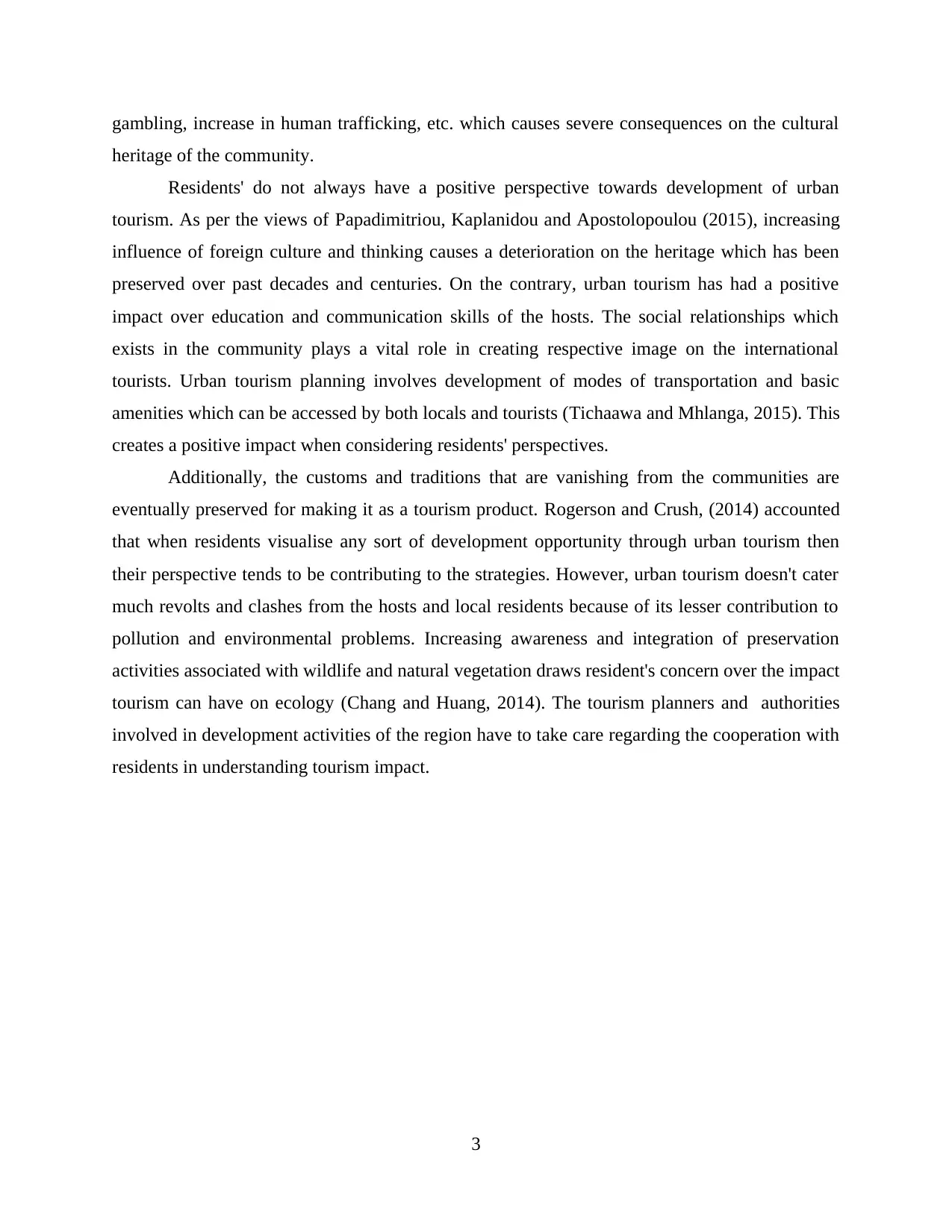
gambling, increase in human trafficking, etc. which causes severe consequences on the cultural
heritage of the community.
Residents' do not always have a positive perspective towards development of urban
tourism. As per the views of Papadimitriou, Kaplanidou and Apostolopoulou (2015), increasing
influence of foreign culture and thinking causes a deterioration on the heritage which has been
preserved over past decades and centuries. On the contrary, urban tourism has had a positive
impact over education and communication skills of the hosts. The social relationships which
exists in the community plays a vital role in creating respective image on the international
tourists. Urban tourism planning involves development of modes of transportation and basic
amenities which can be accessed by both locals and tourists (Tichaawa and Mhlanga, 2015). This
creates a positive impact when considering residents' perspectives.
Additionally, the customs and traditions that are vanishing from the communities are
eventually preserved for making it as a tourism product. Rogerson and Crush, (2014) accounted
that when residents visualise any sort of development opportunity through urban tourism then
their perspective tends to be contributing to the strategies. However, urban tourism doesn't cater
much revolts and clashes from the hosts and local residents because of its lesser contribution to
pollution and environmental problems. Increasing awareness and integration of preservation
activities associated with wildlife and natural vegetation draws resident's concern over the impact
tourism can have on ecology (Chang and Huang, 2014). The tourism planners and authorities
involved in development activities of the region have to take care regarding the cooperation with
residents in understanding tourism impact.
3
heritage of the community.
Residents' do not always have a positive perspective towards development of urban
tourism. As per the views of Papadimitriou, Kaplanidou and Apostolopoulou (2015), increasing
influence of foreign culture and thinking causes a deterioration on the heritage which has been
preserved over past decades and centuries. On the contrary, urban tourism has had a positive
impact over education and communication skills of the hosts. The social relationships which
exists in the community plays a vital role in creating respective image on the international
tourists. Urban tourism planning involves development of modes of transportation and basic
amenities which can be accessed by both locals and tourists (Tichaawa and Mhlanga, 2015). This
creates a positive impact when considering residents' perspectives.
Additionally, the customs and traditions that are vanishing from the communities are
eventually preserved for making it as a tourism product. Rogerson and Crush, (2014) accounted
that when residents visualise any sort of development opportunity through urban tourism then
their perspective tends to be contributing to the strategies. However, urban tourism doesn't cater
much revolts and clashes from the hosts and local residents because of its lesser contribution to
pollution and environmental problems. Increasing awareness and integration of preservation
activities associated with wildlife and natural vegetation draws resident's concern over the impact
tourism can have on ecology (Chang and Huang, 2014). The tourism planners and authorities
involved in development activities of the region have to take care regarding the cooperation with
residents in understanding tourism impact.
3
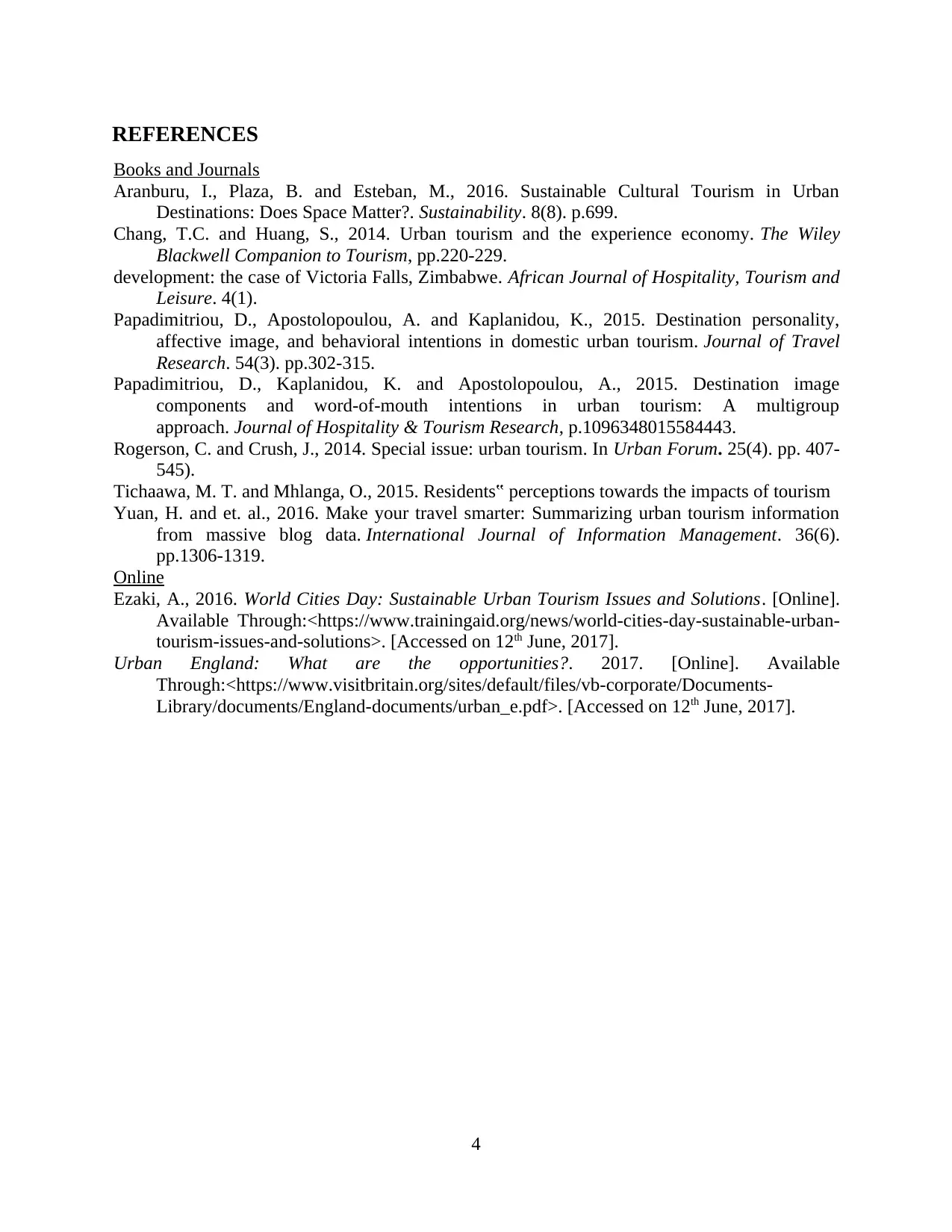
REFERENCES
Books and Journals
Aranburu, I., Plaza, B. and Esteban, M., 2016. Sustainable Cultural Tourism in Urban
Destinations: Does Space Matter?. Sustainability. 8(8). p.699.
Chang, T.C. and Huang, S., 2014. Urban tourism and the experience economy. The Wiley
Blackwell Companion to Tourism, pp.220-229.
development: the case of Victoria Falls, Zimbabwe. African Journal of Hospitality, Tourism and
Leisure. 4(1).
Papadimitriou, D., Apostolopoulou, A. and Kaplanidou, K., 2015. Destination personality,
affective image, and behavioral intentions in domestic urban tourism. Journal of Travel
Research. 54(3). pp.302-315.
Papadimitriou, D., Kaplanidou, K. and Apostolopoulou, A., 2015. Destination image
components and word-of-mouth intentions in urban tourism: A multigroup
approach. Journal of Hospitality & Tourism Research, p.1096348015584443.
Rogerson, C. and Crush, J., 2014. Special issue: urban tourism. In Urban Forum. 25(4). pp. 407-
545).
Tichaawa, M. T. and Mhlanga, O., 2015. Residents‟ perceptions towards the impacts of tourism
Yuan, H. and et. al., 2016. Make your travel smarter: Summarizing urban tourism information
from massive blog data. International Journal of Information Management. 36(6).
pp.1306-1319.
Online
Ezaki, A., 2016. World Cities Day: Sustainable Urban Tourism Issues and Solutions. [Online].
Available Through:<https://www.trainingaid.org/news/world-cities-day-sustainable-urban-
tourism-issues-and-solutions>. [Accessed on 12th June, 2017].
Urban England: What are the opportunities?. 2017. [Online]. Available
Through:<https://www.visitbritain.org/sites/default/files/vb-corporate/Documents-
Library/documents/England-documents/urban_e.pdf>. [Accessed on 12th June, 2017].
4
Books and Journals
Aranburu, I., Plaza, B. and Esteban, M., 2016. Sustainable Cultural Tourism in Urban
Destinations: Does Space Matter?. Sustainability. 8(8). p.699.
Chang, T.C. and Huang, S., 2014. Urban tourism and the experience economy. The Wiley
Blackwell Companion to Tourism, pp.220-229.
development: the case of Victoria Falls, Zimbabwe. African Journal of Hospitality, Tourism and
Leisure. 4(1).
Papadimitriou, D., Apostolopoulou, A. and Kaplanidou, K., 2015. Destination personality,
affective image, and behavioral intentions in domestic urban tourism. Journal of Travel
Research. 54(3). pp.302-315.
Papadimitriou, D., Kaplanidou, K. and Apostolopoulou, A., 2015. Destination image
components and word-of-mouth intentions in urban tourism: A multigroup
approach. Journal of Hospitality & Tourism Research, p.1096348015584443.
Rogerson, C. and Crush, J., 2014. Special issue: urban tourism. In Urban Forum. 25(4). pp. 407-
545).
Tichaawa, M. T. and Mhlanga, O., 2015. Residents‟ perceptions towards the impacts of tourism
Yuan, H. and et. al., 2016. Make your travel smarter: Summarizing urban tourism information
from massive blog data. International Journal of Information Management. 36(6).
pp.1306-1319.
Online
Ezaki, A., 2016. World Cities Day: Sustainable Urban Tourism Issues and Solutions. [Online].
Available Through:<https://www.trainingaid.org/news/world-cities-day-sustainable-urban-
tourism-issues-and-solutions>. [Accessed on 12th June, 2017].
Urban England: What are the opportunities?. 2017. [Online]. Available
Through:<https://www.visitbritain.org/sites/default/files/vb-corporate/Documents-
Library/documents/England-documents/urban_e.pdf>. [Accessed on 12th June, 2017].
4
⊘ This is a preview!⊘
Do you want full access?
Subscribe today to unlock all pages.

Trusted by 1+ million students worldwide
1 out of 6
Related Documents
Your All-in-One AI-Powered Toolkit for Academic Success.
+13062052269
info@desklib.com
Available 24*7 on WhatsApp / Email
![[object Object]](/_next/static/media/star-bottom.7253800d.svg)
Unlock your academic potential
Copyright © 2020–2025 A2Z Services. All Rights Reserved. Developed and managed by ZUCOL.




